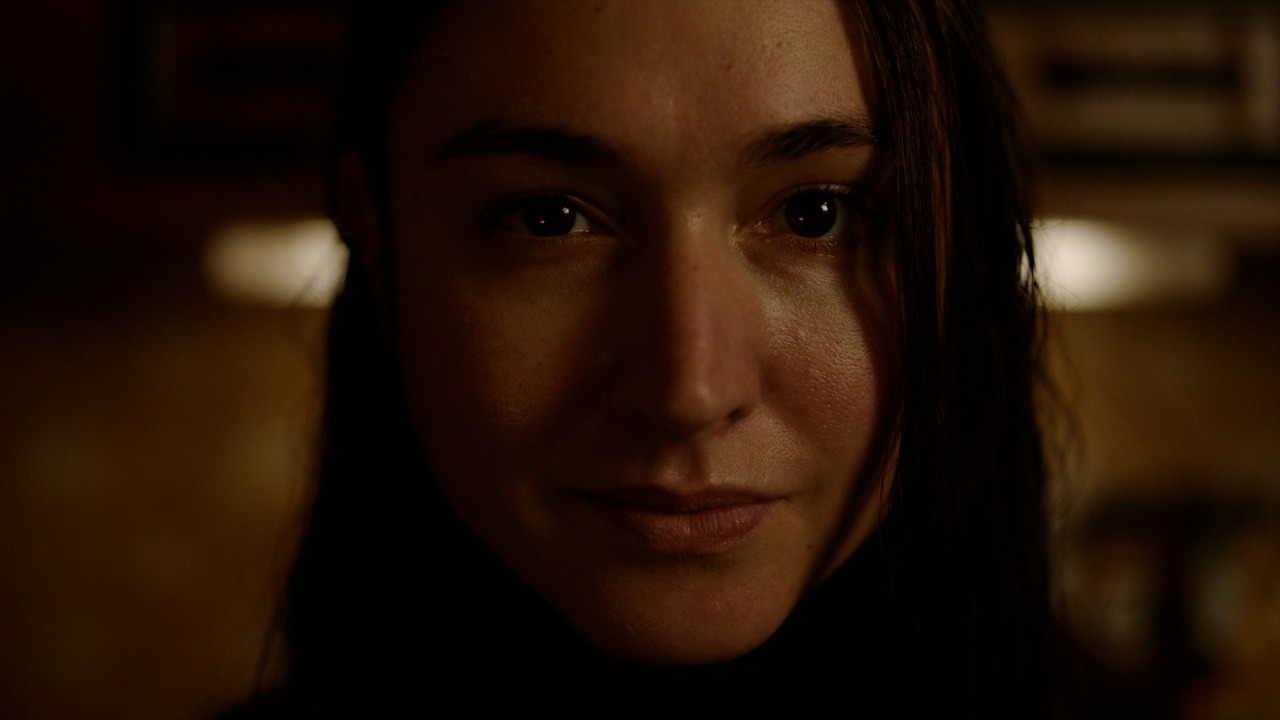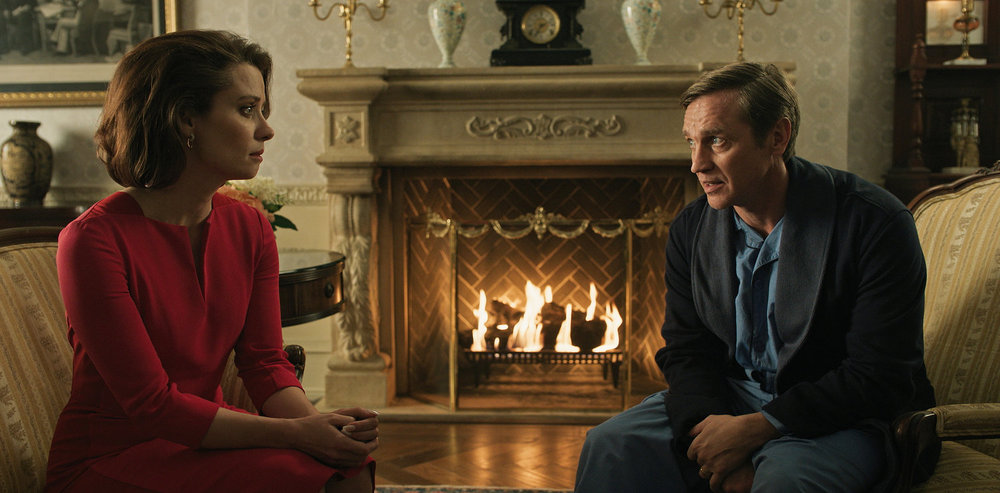Interviews
‘You’ll Never Find Me’ – Directors Indianna Bell and Josiah Allen Discuss Challenges in Creating Single-Location Horror [Interview]

Claustrophobic chamber piece You’ll Never Find Me, the feature directorial debut by Indianna Bell and Josiah Allen, just debuted at the Tribeca Film Festival, where it introduced a haunting new entry in Australian horror.
In the film, “An isolated man living in the back of a desolate caravan park is visited by a desperate young woman seeking shelter from a violent storm. As the savage storm worsens, these solitary souls begin to feel threatened- but who should really be afraid?”
Jordan Cowan and Brendan Rock star in the intimate horror feature penned by Bell.
You’ll Never Find Me employs a classic horror setup – a raging storm traps two strangers alone at a remote location in the dark. Bell and Allen use the familiar setting to introduce a grim, contemporary horror story. The filmmakers spoke with Bloody Disgusting at Tribeca, discussing their debut’s origins and horror influences.
Bell wanted to subvert the conventional depiction of Australians in her debut feature: “We have a traditional style of film that comes out of Australia that portrays Australians in, often it’s a very positive light. It’s the guy with the ute and the dog, and he’s gorgeous, and he’s buff, and he’s tanned, and all that stuff. Which is great; we love gorgeous, buff, tanned Australian men. But at the same time, Australia is a really interesting place, and it has a lot of weird and interesting people who live there. Because we are such a large country with such a small population, it creates these pockets of little towns and lots of very isolated people, and people who perhaps are isolated for a reason or want to be isolated. When you encounter those people, you go, ‘Oh, that’s a side of Australia that I don’t think we present very much in films.'”
There’s a deceptiveness to the simplicity of You’ll Never Find Me. Two characters in one location for the film’s entire runtime leaves nowhere to hide; every element is essential, from lighting to staging to acting and everything in between.
Bell said of the challenges, “The hilarious thing about this whole process is that you think, ‘Oh, one location, two characters is simplifying filmmaking. It’s a nice simple thing to do for a first feature.’ That is just so wrong. It was really hard. And it’s one of those things that, sure, having a single location and two characters practically and for a shooting schedule does help, and it’s great. Everyone being together in the same place every day, really familiar with it, and you can pick up where you left off; it is great for a shooting schedule and awesome. But then, when it comes to it, it just puts so much more emphasis, like you said, on everything else, and everything else becomes really important, and every little detail in the house becomes really important. How you light everything becomes really important. How you keep everyone’s attention during the film becomes really important.”
“There was nothing to hide behind,” Allen elaborates. “Everything needed purpose. I think whether they’re aware of it or not, because we constantly present certain clues of what’s happening internally with the characters, you quickly realize you can’t have a meandering shot. Because the audience will start to overanalyze it. Again, even if they’re not used to analyzing the cinematic language, they do. For example, there were some scenes where we had a second camera going for coverage, and we could never use it because it just had to have such a specific point of view at all times.”

Image Credit: Tribeca Film Festival
While Bell and Allen succeed in capturing a quintessential haunted mood, their influences are very modern.
“Maxx Corkindale, our cinematographer, was just awesome,” Bell explains. “We spoke a lot to him about what we can do to keep the film fresh and visually interesting throughout when it’s all in one space, and changing up the lighting scheme as the film progresses to make it feel like it’s a new environment, even though we’re in the same place that we were in 20 minutes ago. In terms of a specific film, though, we did look a lot at the unusual stilted nature of Servant, the show, because we loved how they’re telling you something’s off just through the visual language of that show. It’s got this stilted nature to it, which we liked.“
Allen cites even more unexpected sources of inspiration: “I think we broke it up into sections; that’s the best way of thinking about it. I think we, like everyone, love people like David Fincher, but that was more broad for the first section. It’s not like we were going to Maxx, ‘Oh, we want it to feel like David Fincher,’ it’s just that he does that really interesting thing where he’s always with the characters; it never feels like there’s someone in the room filming like a documentary, you actually forget. Sometimes people overanalyze stuff like that, but in those filmmakers, the camera is just there, and you don’t ever think about the camera being there. It cumulatively creates an unsettling feeling. Perfectly following someone around, for some reason, gives you an unsettling feeling. And then, when you choose to then pan away from the character, you’re so used to constantly being with the camera that you’re like, ‘Why am I looking over there?’
“So, we talked about having a lot of restraint with the camera for that first section, constantly being connected to the characters, not being distracting, but having a real purpose. And then, once a variety of things happen and there’s a big lighting change, the power goes out. A film called It Comes At Night, which we love, used practical lighting in an interesting way. Not the classic cinema darkness.”
“But true dark,” Bell adds.
“True dark,” Allen nods. “We have a few shots which turn out interestingly, where someone’s walking through a space or a hall, and you can only see 10% of the frame. And I think that feels claustrophobic, changes up the space in an interesting way, but hopefully, you’re always feeling like there could be something in the shadows without us being, again, too there with it. The goal was, if we’re always feeling like something’s off and there’s this pressure-cooking, once we release the pressure, we throw all those rules out the window.”

Interviews
“Chucky” – Devon Sawa & Don Mancini Discuss That Ultra-Bloody Homage to ‘The Shining’

Only one episode remains in Season 3 of “Chucky,” and what a bloody road it’s been so far, especially for actor Devon Sawa. The actor has now officially died twice on screen this season, pulling double duty as President James Collins and body double Randall Jenkins.
If you thought Chucky’s ruthless eye-gouging of the President was bloody, this week’s Episode 7 traps Randall Jenkins in an elevator that feels straight out of an iconic horror classic.
Bloody Disgusting spoke with series creator Don Mancini and actor Devon Sawa about that ultra-bloody death sequence and how the actor inspires Mancini’s writing on the series.
Mancini explains, “Devon’s a bit of a muse. Idle Hands and Final Destination is where my Devon Sawa fandom started, like a lot of people; although yours may have started with Casper. I was a bit too old for that. But it’s really just about how I love writing for actors that I respect and then know. So, it’s like having worked with Devon for three years now, I’m just always thinking, ‘Oh, what would be a fun thing to throw his way that would be unexpected and different that he hasn’t done?’ That’s really what motivates me.”
For Sawa, “Chucky“ is an actor’s dream in that the series gives him not one but multiple roles to sink his teeth into, often within the same season. But the actor is also a huge horror fan, and Season 3: Part 2 gives him the opportunity to pay homage to a classic: Kubrick’s The Shining.

CHUCKY — “There Will Be Blood” Episode 307 — Pictured in this screengrab: (l-r) Devon Sawa as President James Collins, K.C. Collins as Coop — (Photo by: SYFY)
“Collectively, it’s just amazing to put on the different outfits, to do the hair differently, to get different types of dialogue,“ Sawa says of working on the series. “The elevator scene, it’s like being a kid again. I was up to my eyeballs in blood, and it felt very Kubrick. Everybody there was having such a good time, and we were all doing this cool horror stuff, and it felt amazing. It really was a good day.”
Sawa elaborates on being submerged in so much blood, “It was uncomfortable, cold, and sticky, and it got in my ears and my nose. But it was well worth it. I didn’t complain once. I was like, ‘This is why I do what I do, to do scenes like this,‘ the scenes that I grew up watching on VHS cassette, and now we’re doing it in HD, and it’s all so cool.“
It’s always the characters and the actors behind them that matter most to Mancini, even when he delights in coming up with inventive kills and incorporating horror references. And he’s killed Devon Sawa’s characters often. Could future seasons top the record of on-screen Sawa deaths?
“Well, I guess we did it twice in season one and once in season two,“ Mancini counts. “So yeah, I guess I would have to up the ante next season. I’ll really be juggling a lot of falls. But I think it’s hopefully as much about quality as quantity. I want to give him a good role that he’s going to enjoy sinking his teeth into as an actor. It’s not just about the deaths.”
Sawa adds, “Don’s never really talked about how many times could we kill you. He’s always talking about, ‘How can I make this death better,’ and that’s what I think excites him is how he can top each death. The electricity, to me blowing up to, obviously in this season, the eyes and with the elevator, which was my favorite one to shoot. So if it goes on, we’ll see if he could top the deaths.”

CHUCKY — “Death Becomes Her” Episode 305 — Pictured in this screengrab: Devon Sawa as James Collins — (Photo by: SYFY)
The actor has played a handful of distinctly different characters since the series launch, each one meeting a grisly end thanks to Chucky. And Season 3 gave Sawa his favorite characters yet.
“I would say the second one was a lot of fun to shoot,“ the actor says of Randall Jenkins. “The President was great. I liked playing the President. He was the most grounded, I hope, of all the characters. I did like playing him a lot.” Mancini adds, “He’s grounded, but he’s also really traumatized, and I thought you did that really well, too.”
The series creator also reveals a surprise correlation between President James Collins’ character arc and a ’90s horror favorite.
“I saw Devon’s role as the president in Season 3; he’s very Kennedy-esque,“ Mancini explains. “But then given the supernatural plot turns that happen, to me, the analogy is Michelle Pfeiffer in What Lies Beneath, the character that is seeing these weird little things happening around the house that is starting to screw with his sanity and he starts to insist, ‘I’m seeing a ghost,‘ and his spouse thinks he’s nuts. So I always like that. That’s Michelle Pfeiffer in What Lies Beneath, which is a movie I love.”
The finale of “Chucky” Season 3: Part 2 airs Wednesday, May 1 on USA & SYFY.













You must be logged in to post a comment.